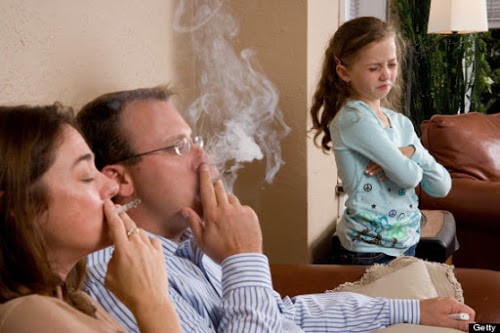It's not just secondhand smoke that is dangerous. Thirdhand smoke can be, too
You can tell the dude sitting next to you in the movie theater is a smoker or vaper; you can smell it on his clothes. But since he's not lighting up and puffing smoke your way, it's OK, right?
Not at all.
A new study out of Yale University says thirdhand smoke -- the tobacco contaminants that adhere to walls, bedding, carpet and other surfaces until a room smells like an ashtray -- can actually cling to a smoker's body and clothes as well.
Those potentially toxic chemicals, including nicotine, can then be released into environments where smoking has never occurred, like your movie theater, according to the study.
Even more disturbing: The study found those chemical exposure levels could be the equivalent of between one and 10 cigarettes by the end of the movie.
"People are substantial carriers of thirdhand smoke contaminants to other environments," said study author Drew Gentner, an associate professor of chemical and environmental engineering at Yale.
The study, published Wednesday in the journal Science Advances, may be the first to show that people can transmit nicotine and other potentially toxic chemicals via their clothing after smoking, he said.
"That was the unique part of this study," Gentner continued. "We were surprised by the wide array of hazardous volatile organic compounds that were off-gassing from the audience -- including some that are known to be known carcinogens in people, such as benzene and formaldehyde."
What is 'thirdhand smoke'?
Thirdhand "smoke" isn't actually smoke at all. It's the residue of nicotine and other chemicals in tobacco, some of which are toxic, that remain long after active smoking is over.
Some of these chemicals stick to surfaces, and others attach to dust particles. Still others often penetrate deep into wallboard, drapes and upholstery. As the compounds linger, they may react with oxidants or other particles in the room's atmosphere. The chemical reactions can create potentially harmful byproducts that can become airborne.
Science has known about this type of environmental pollution for years, sparking the creation of smoking and non-smoking rooms at hotels, restaurants and the like.
But thirdhand smoke has also been found in environments which were not known to be contaminated by smokers, which led researchers to ask how that could happen.
To find out, Gentner and some of his PhD students set up an experiment in a movie theater that had not allowed smoking for more than 15 years. They supplied fresh air into the theater, making sure that no smoking or other contaminants entered the space.
Sophisticated equipment measured airborne particles before and after moviegoers arrived. Right away, they saw a huge spike in levels of hazardous chemicals.
As people came into the theater, the concentrations went up, and then decreased over time, Gentner said.
"But they didn't completely disappear after the audience left," he added. "In many cases, the persistent contamination was observable the following day in the unoccupied theater."
The testing continued over a four-day period across different movie genres. Perhaps not surprisingly, levels of nicotine and other chemicals were lower in the G-rated movies geared toward kids.
"Despite cases where we had audiences of over 200 people for some of the G-rated movies, the pollutants were much larger for R-rated films, even with smaller audiences," Gentner said. "Those movies would likely draw older audiences that might be more likely to smoke."
Dangerous exposure?
Despite declines in smoking in some developed nations, there are still over a billion smokers worldwide, according to the World Health Organization.
"That billion smokers contribute to about 880,000 deaths from secondhand smoke," said Dr. Jagat Narula, a cardiologist at Mount Sinai Morningside in New York City who researches the health impact of smoking. "I call it a form of murder."
Learning about the Yale study's findings on the level of off-gassing from human bodies and clothing was not surprising, said Narula, who was not involved in the study.
"But it is disturbing," he said. "Numerous reports have shown that there is no safe level of exposure to secondhand smoke.
"If future research replicates these findings on thirdhand smoke, it means that smokers could potentially still do harm even if the act of smoking took place in a different space."
And it's not just smoking tobacco cigarettes. In America, vaping is growing in popularity, enticing younger and younger age groups.
The study wasn't set up to study vaping, Gentner said, and researchers didn't find any of the compounds known to come from vaping emissions other than nicotine.
Still, he said, levels of nicotine were high. Therefore, it's possible that vapers could also be the source of some of the nicotine found by the analysis.
"Nicotine from e-cigarettes could have also been transported by people and off-gassed in the theater, or this could be occurring in other places where people enter after vaping," Gentner said.
Clarity will come with additional research, Narula said. In the meantime, "the concentration of toxic organic compounds off-gassed by smokers cannot be seen as insignificant."
"If the findings hold true, the implication is that essentially we are going to need to make everything smoke-free," Narula said. "And the only way that you will be able to do that is nothing short of banning smoking everywhere."
16/03/2020








comments